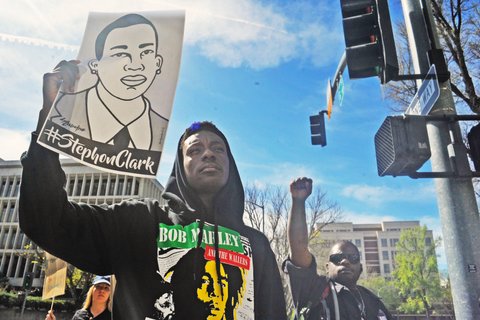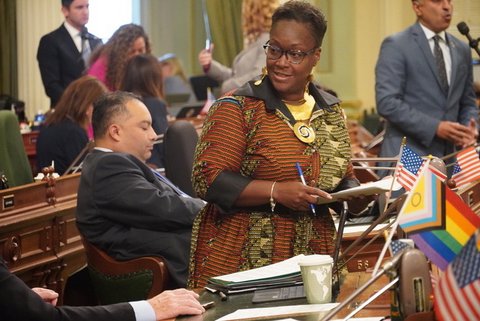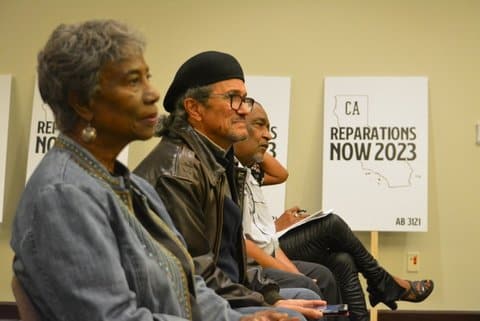
19 Aug Remembering the Victims: Cops Have Killed 107 Black Californians Using Deadly Force Since 2015

California Black Media Takes a Look at 17 of the Most High-Profile Cases
By Antonio Ray Harvey | California Black Media
Today, Gov. Newsom signed AB 392 into law. The legislation limits when law enforcement can use lethal force in California.
In May, less than a week after the Assembly approved the landmark bill that Black Legislative Caucus chair Shirley Weber (D-San Diego) authored, police officers in Walnut Creek, a suburb of Oakland, shot and killed Miles Hall. He was a 23-year-old African-American man.
In the police report of the incident, which happened June 2, police officers say Hall threatened his mother before she called them to the scene of the killing. He was reportedly carrying a metal pole.
Since Hall’s death, there have been six more police-involved shootings in the state.
California has one of the highest rates of police shootings in the country. Citing numbers from 2013 to 2017, an advocacy group called Mapping Police Violence, ranked the Bakersfield Police Department the fifth deadliest in the United States. And The Guardian reported that Kern County had the “deadliest police force in the country” in 2015, a ranking determined by the Central Valley county’s high rate of officer-involved shootings per capita that year.
According to a Washington Post database tracking police killings of civilians since 2015, there have been a total of 661 police-involved shootings in California over the last 4 years. Of that number, California police officers shot and killed 107 African Americans.
Across the country, there have been a total of 4,510 police-involved fatal shootings within that same four-and-a-half-year period.
Up until Aug 17, 2019, police officers have killed 570 people by deadly force across the country. In California, this year alone, there have been 79 deaths resulting from police officer shootings. Twelve of the those killed were Black Californians.
In this report, California Black Media revisits 17 of the most prominent cases of police deadly force involving African American victims in the state since 1998.
Tyisha Miller, 19 (Riverside)
On Dec. 28, 1998, Tyisha Miller was reportedly unconscious, sitting inside a locked vehicle with a handgun, in full view, in her lap.
Police officers, responding to a 911 call from a Unocal 76 station, broke the vehicle’s window in an attempt to reach Miller.
Four police officers – two who were on the force for less than a year at the time of the incident – pulled out their weapons and fired 23 shots.
Twelve bullets hit Miller, taking her life.
The public later learned that Miller locked her car and fell asleep while the car was idling. She was reportedly waiting for help to fix a flat tire.
A friend who was riding with Miller earlier said she had gone back to where they lived to get someone to help them.
Over $22 million was spent to settle the case, reports say.
The incident prompted then-California Attorney General Bill Lockyer to order reforms to police use-of-force and lethal weapon guidelines. Riverside County’s Press-Enterprise reported in Dec. 2014 that the most significant police department changes were described in an agreement known as a “stipulated judgement” brokered between the city of Riverside and Lockyer.
“The stipulation became the first of its kind in the county. It was California’s version of federal consent decrees that “mandated changes in departments found to have patterns of discrimination, excessive force or other civil rights violations,” the Press-Enterprise wrote on Dec. 19, 2014.
Oscar Grant, 22, (Oakland)
During the early hours of New Year’s Day 2009, Oscar Grant, the father of one child, was shot in the back and killed by Bay Area Rapid Transit (BART) officer Johannes Mehserle. Before the tragic incident, Grant had been detained on the platform of the Fruitvale BART train station in Oakland.
In May, a newly unsealed BART internal report confirmed that Grant’s death was more than likely not an accident and that one of the cops involved lied numerous times about the events leading up to Grant’s death.
Senate Bill 1421, a California police transparency bill that went into effect this year, made it possible for journalists to make a request for BART’s police report of the incident and release it to the public.
SB 1421 is expected to increase accuracy in police reports about the details of officer-involved shootings and cases.
On July 8, 2010, Mehserle was found guilty of involuntary manslaughter, but not guilty of the murder and voluntary manslaughter charges. He claimed he was reaching for his Taser and not his weapon.
Grant’s shooting sparked waves of protests in Oakland and across the country that led to the arrests of more than100 people.
James Rivera, 16 (Stockton)
James Rivera was shot 38 times by Stockton Police Department officers on July 22, 2010.
In 2012, the San Joaquin DA’s office ruled that the deadly use of force was justified, alleging that Rivera was driving a stolen van in reverse at high speed, intending to hit the officers.
Then in July 2017, a federal judge for the Eastern District of California said in a 12-page ruling that the officers’ testimonies were inconsistent and that the plaintiffs raised reasonable doubt as to whether it was possible for Rivera to back up the van out of a garage.
The judge ruling opened a path for a jury trial in a wrongful death lawsuit expected to begin in November.
Shaleem Tindle, 28 (Oakland)
On Jan. 3, 2018, Shaleem Tindle was shot three times in the back by a BART officer in West Oakland. Police alleged that he was in a fight with another man and that Tindle was carrying a gun.
The Alameda County District Attorney cleared BART Police Officer Joseph Mateu of all charges related to Tindle’s shooting in October 2018.
Tindle was reportedly walking to the BART Station with his fiancée, two young children, and his fiancee’s sister when he got into an argument with another man.
The two ended up wrestling on the sidewalk outside a barber shop and taqueria.
Police say two shots were fired during the tussle.
Officer Mateu heard the shots from his position in a BART Station about a block away. He ran toward the scene where he found the men grappling before shooting Tindle.
Manuel Loggins, 31 (San Clemente)
On Feb. 7, 2012, an Orange County Sheriff’s Deputy shot and killed Manuel Loggins, a U.S. Marine sergeant and married father of three.
The officer shot Loggins through the window of his vehicle.
According to the police report, Loggins allegedly crashed through a parking lot gate at San Clemente High School while driving his GMC Yukon with his two daughters, then ages 9 and 14, in the car.
The officer said he asked Loggins, who was unarmed, to show his hands before he shot him three times.
Loggins was reportedly a devout Christian.
Kendrec McDade, 19 (Pasadena)
On March 24, 2012, two Pasadena police officers shot and killed Kendrec McDade.
The cops said they were responding to a robbery report when they encountered the local football star and Pasadena City College student.
McDade was unarmed and had no criminal record.
Some witnesses said McDade was at the “wrong the place at the wrong time.”
A caller, who reported that a backpack and laptop were stolen at gunpoint, later confessed that the reported strong-arm robbery never occurred. He said he made up the story to get a quicker response from police.
McDade, who was in the vicinity when police arrived, allegedly ran when he was approached by the police.
The cops, then, reportedly began to pursue him.
The officers said they feared for their lives after chasing McDade into a dark alley. They claim McDade turned around and ran toward the patrol call and that he reached for a weapon in his pants.
The officers shot McDade four times.
Ezell Ford, 25 (Florence)
In January 2017, the city of Los Angeles agreed to pay $1.5 million to the family of Ezell Ford, who was fatally shot by two LAPD police officers on Aug. 11, 2014.
Ford’s family said he had been diagnosed with depression, bi-polar disorder and schizophrenia.
The LA District Attorney’s Office did not file charges against the officers who say they approached Ford because he was acting suspicious and allegedly tried to dispense an illegal substance, according to their official report.
The officers claim they had to physically struggle with Ford before using deadly force against him, saying they feared for their lives.
Ford’s family says he was shot three times while lying on the ground.
He died two hours after the shooting at the California Hospital Medical Center in downtown Los Angeles.
Dante Parker, 36 (Victorville)
Dante Parker, the father of five children, was tasered multiple times by a deputy from the San Bernardino County’s Sheriff’s Department on Aug. 12, 2014. Prosecutors say the deputy’s actions were justified and that Parker had PCP in his system.
The deputy was reportedly responding to a call about a man who was breaking into a home.
Deputies said Parker, who was about 5 feet, two inches and weighed around 300 pounds, fit the description of the suspect.
They also claim Parker was “combative,” did not cooperate with authorities and resisted arrest.
According to reports, Parker was tasered about a dozen times while deputies scuffled with him.
Apparently, the deputies were able to handcuff him, place him in a patrol car, and administer medical aid.
After arriving at Victor Valley Global Hospital, Parker went into cardiac arrest and died. His autopsy report ruled his death accidental.
His family settled for $250,000 in June 2016.
Charley “Africa” Leundeu Keunang, 43 (Los Angeles)
Charley Keunang, a homeless Cameroonian immigrant, was shot and killed by three LAPD officers after he supposedly reached for a cop’s holstered gun during a struggle in the city’s Skid Row area on March 1, 2015.
Keunang was accused of attacking another homeless person and throwing his tent in the streets.
A bystander recorded the melee between Keunang and the officers before the shooting. Keunang was shot six times.
The shooting death attracted worldwide attention when someone posted a Facebook video of the incident.
An autopsy revealed that Keunang had methamphetamine in his system.
In 2016, the Los Angeles police commission ruled that the officers’ actions were justifiable and the use of lethal force was necessary.
The Los Angeles City Council approved $1.95 million to settle Keunang’s case. His family had originally sought $20 million from the city.
Brendon Glenn, 29 (Los Angeles)
The city of Los Angeles settled the officer-involved shooting of Brendon Glenn for $4 million in December 2016.
He was an unarmed homeless man who struggled with a Black officer on the Venice beach boardwalk before he was killed on May 5, 2015.
Two officers were responding to a call from a bar that reported a man harassing people. One of the officers said Glenn was trying to reach for his partner’s gun before he made the decision to shoot him.
The shooting was captured on video but the footage, obtained from a nearby bar’s surveillance camera, did not show Glenn’s hands near the officers’ guns at any point.
They city awarded the $4 million settlement to Glenn’s mother and his then 4-year-old son.
Mario Woods, 26 (San Francisco)
In June, the city of San Francisco announced that it will pay the mother of Mario Woods $400,000 in monetary damages.
On Dec. 2, 2015, five cops shot Woods. He was a suspect in a stabbing.
Woods was running away from the police, according to the report, when the officers shot him 21 times, some of the bullets hitting him in the back.
An autopsy found Woods had drugs in his system.
Protests of Woods’ shooting, which was captured on video, led to the resignation of police chief Greg Suhr.
Alfred Olango, 38 (El Cajon)
A former refugee from Uganda, Alfred Olango suffered four wounds to the neck, chest, arm and shoulder when police officers shot him on September 27, 2016. The cops also used a stun gun to shock him twice.
Police claim Olango pulled out a vaping e-cigarette device and pointed it at them in front of a shopping center. Another officer, during the shooting, used a Taser gun, hitting Olango in the buttocks and leg.
A drug test found cocaine in Olango’s system and a small amount of alcohol in his bloodstream.
Olango’s family said he had a mental breakdown after the death of a close friend.
Prosecutors ruled that the El Cajon officer’s actions were justifiable in using deadly force to kill Olango.
Joseph Mann, 51 (Sacramento)
Joseph Mann, a mentally ill and homeless man, was shot and killed by two Sacramento Police Department officers on July 11, 2016. A video, provided by Sacramento Regional Transit and released by the Sac Police Department, graphically showed the final seconds of Mann’s life before he fell to a hail of police gunfire.
One of the police officers tried running Mann over with his cruiser before the cops fired 18 shots. At least 14 of them hit Mann.
The video shows Mann clearly running down the sidewalk. At some point, he turned to face officers in the street who began shooting immediately. The officers, who appeared to be about six or seven paces away from Mann when he fell, said he had a knife.
The Sacramento County District Attorney’s Office backed the actions of the two police officers involved, citing that they “lawfully shot” Mann.
Diante Yarber, 26 (Barstow)
Diante Yarber was fatally shot by Barstow police officers on April 5, 2018 in a Walmart parking lot.
Police say Yarber reversed his Ford Mustang into a patrol car, and then drove forward in the direction of officers, slamming into another police car before they decided to use deadly force.
According to other reports, Yarber drove into the parking lot to pick up someone who was shopping at Walmart.
Police say they believe Yarber was the suspect in a stolen car case. Three other people were in the car with Yarber when the police fired at the vehicle. Only one of the passengers was wounded in the shooting.
Yarber’s family lawyers say he was struck by 10 bullets.
Barstow police said a total of 24 rounds were shot at the vehicle.
Prosecutors cleared officers Jimmie Alfred Walker, Jose Barrientos, Vincent Carrillo and Matthew Allen Helms of all charges in Yarber’s shooting.
Walker, who is White, was charged with hate crimes and battery in separate incident in 2010.
Attorneys for Yarber’s family have filed a wrongful death lawsuit. They say their client did not receive proper medical treatment after the shooting and that he choked on his blood.
Yarber left behind three daughters.
Stephon Alonzo Clark, 22 (Sacramento)
On March 2, 2019, nearly one year after Clark was shot and killed in his grandmother’s backyard, Sacramento’s District Attorney Anne Marie Schubert announced that she would not press charges against the two Sacramento Police Department officers who gunned down the unarmed 22-year-old.
The police officers, Terrence Mercadal and Jared Robinet, shot and killed Clark in South Sacramento on March 18, 2018. Clark was unarmed and holding a cell phone.
Seven out of about 20 bullets the policemen fired hit the former Sacramento High athlete from the back, according to an independent autopsy report conducted by the family.
The official police report says Clark, the father of two infant sons, was facing and approaching officers when they killed him.
He was a vandalism suspect.
Clark’s death sparked protests around the country and in his hometown Sacramento, which led to the shutting down of two Sacramento Kings games at Golden 1 Center.
De’Andre Mitchell, 23 (Torrance)
Christopher De’Andre Mitchell was shot and killed by a Torrance police officer on Dec. 9, 2018, after cops said he didn’t follow their orders to get out of the car.
According to Torrance police chief Eve Irvine, Mitchell reached for a gun he was holding between his legs.
Investigations later found that the weapon was an air rifle.
Mitchell was shot in a Ralph’s parking lot while sitting in 2000 Honda Civic that was reported stolen two days prior, according to the police.
Mitchell died while being treated for injuries after the officers took him out of the car about 37 minutes after the shooting.
Willie McCoy, 20 (Vallejo)
On Feb. 9, 2019, police officers, responding to a 911 call, shot Willie McCoy in his throat and chest.
McCoy, who appeared to be sleeping in his car in a Taco Bell drive-thru when the incident happened, was a rapper also known as “Willie Bo.”
Police said McCoy allegedly woke up and was reaching for a gun on his lap before they shot him.
The Vallejo Police Department has released footage captured on the body-worn cameras of six officers who engaged in using deadly force against McCoy.
In 2012, a third of Vallejo’s homicides resulted from police officer-involved shootings and the city’s police officers used deadly force 38 times the national rate that same year.






No Comments